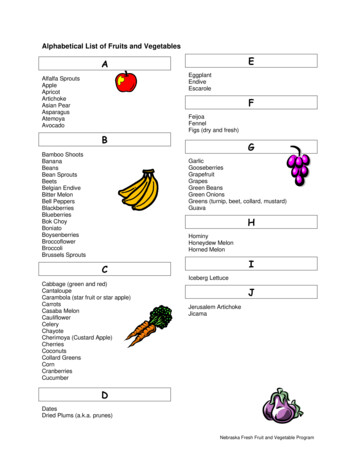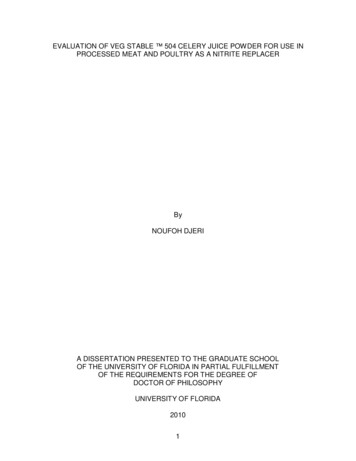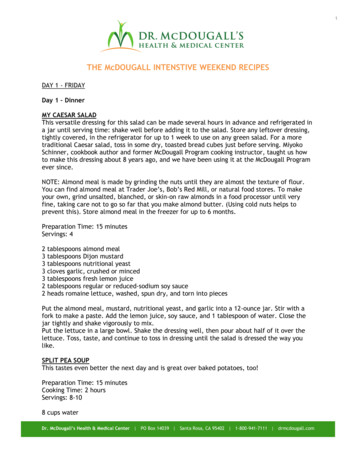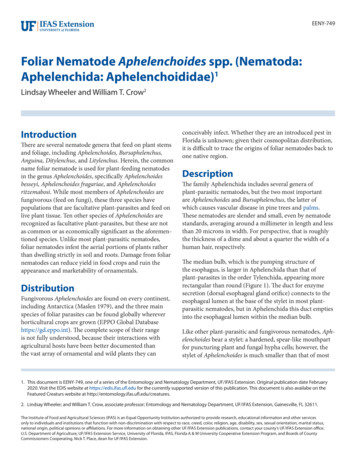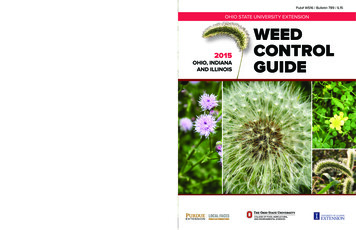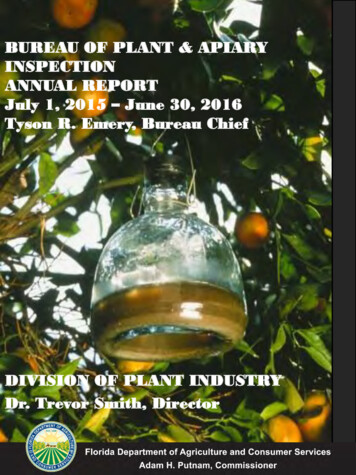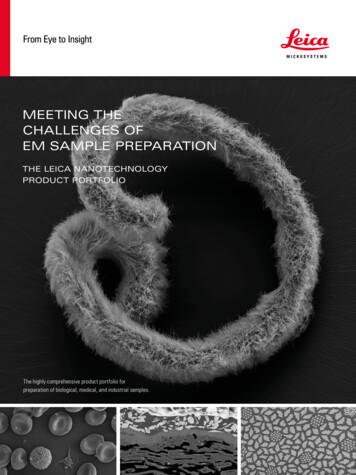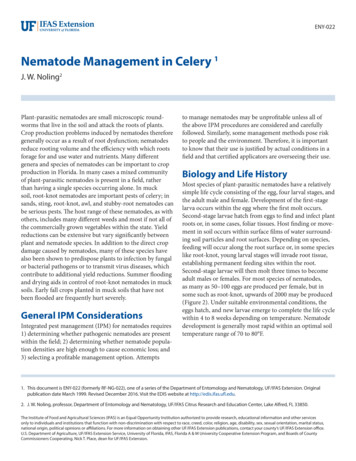
Transcription
ENY-022Nematode Management in Celery 1J. W. Noling2Plant-parasitic nematodes are small microscopic roundworms that live in the soil and attack the roots of plants.Crop production problems induced by nematodes thereforegenerally occur as a result of root dysfunction; nematodesreduce rooting volume and the efficiency with which rootsforage for and use water and nutrients. Many differentgenera and species of nematodes can be important to cropproduction in Florida. In many cases a mixed communityof plant-parasitic nematodes is present in a field, ratherthan having a single species occurring alone. In mucksoil, root-knot nematodes are important pests of celery; insands, sting, root-knot, awl, and stubby-root nematodes canbe serious pests. The host range of these nematodes, as withothers, includes many different weeds and most if not all ofthe commercially grown vegetables within the state. Yieldreductions can be extensive but vary significantly betweenplant and nematode species. In addition to the direct cropdamage caused by nematodes, many of these species havealso been shown to predispose plants to infection by fungalor bacterial pathogens or to transmit virus diseases, whichcontribute to additional yield reductions. Summer floodingand drying aids in control of root-knot nematodes in mucksoils. Early fall crops planted in muck soils that have notbeen flooded are frequently hurt severely.General IPM ConsiderationsIntegrated pest management (IPM) for nematodes requires1) determining whether pathogenic nematodes are presentwithin the field; 2) determining whether nematode population densities are high enough to cause economic loss; and3) selecting a profitable management option. Attemptsto manage nematodes may be unprofitable unless all ofthe above IPM procedures are considered and carefullyfollowed. Similarly, some management methods pose riskto people and the environment. Therefore, it is importantto know that their use is justified by actual conditions in afield and that certified applicators are overseeing their use.Biology and Life HistoryMost species of plant-parasitic nematodes have a relativelysimple life cycle consisting of the egg, four larval stages, andthe adult male and female. Development of the first-stagelarva occurs within the egg where the first molt occurs.Second-stage larvae hatch from eggs to find and infect plantroots or, in some cases, foliar tissues. Host finding or movement in soil occurs within surface films of water surrounding soil particles and root surfaces. Depending on species,feeding will occur along the root surface or, in some specieslike root-knot, young larval stages will invade root tissue,establishing permanent feeding sites within the root.Second-stage larvae will then molt three times to becomeadult males or females. For most species of nematodes,as many as 50–100 eggs are produced per female, but insome such as root-knot, upwards of 2000 may be produced(Figure 2). Under suitable environmental conditions, theeggs hatch, and new larvae emerge to complete the life cyclewithin 4 to 8 weeks depending on temperature. Nematodedevelopment is generally most rapid within an optimal soiltemperature range of 70 to 80 F.1. This document is ENY-022 (formerly RF-NG-022), one of a series of the Department of Entomology and Nematology, UF/IFAS Extension. Originalpublication date March 1999. Revised December 2016. Visit the EDIS website at http://edis.ifas.ufl.edu.2. J. W. Noling, professor, Department of Entomology and Nematology, UF/IFAS Citrus Research and Education Center, Lake Alfred, FL 33850.The Institute of Food and Agricultural Sciences (IFAS) is an Equal Opportunity Institution authorized to provide research, educational information and other servicesonly to individuals and institutions that function with non-discrimination with respect to race, creed, color, religion, age, disability, sex, sexual orientation, marital status,national origin, political opinions or affiliations. For more information on obtaining other UF/IFAS Extension publications, contact your county’s UF/IFAS Extension office.U.S. Department of Agriculture, UF/IFAS Extension Service, University of Florida, IFAS, Florida A & M University Cooperative Extension Program, and Boards of CountyCommissioners Cooperating. Nick T. Place, dean for UF/IFAS Extension.
SymptomsTypical symptoms of nematode injury can involve bothaboveground and belowground plant parts. Foliar symptoms of nematode infestation of roots generally involvestunting and general unthriftiness, premature wilting, andslow recovery to improved soil moisture conditions, leafchlorosis (yellowing), and other symptoms characteristic ofnutrient deficiency. An increased rate of ethylene production, thought to be largely responsible for symptom expression in tomato, has been shown to be closely associatedwith root-knot nematode root infection and gall formation.Plants exhibiting stunted or decline symptoms usuallyoccur in patches of non-uniform growth rather than as anoverall decline of plants within an entire field (Figure 1).Figure 2. Root-knot nematode (Meloidogyne spp.) induced stuntingand galling of celery. Note the enlarged, tumerous type expansions(galls) of the roots.assuming a swollen appearance (Figure 3). New rootinitials generally are killed by heavy infestations of thesting nematode, a symptom reminiscent of fertilizer saltburn. Root symptoms induced by root-knot cause swollenareas (galls) on the roots of infected plants (Figure 4). Gallsize may range from a few spherical swellings to extensiveareas of elongated, convoluted, tumorous swellings, whichresult from exposure to multiple and repeated infections.Symptoms of root galling can in most cases provide positivediagnostic confirmation of nematode presence, infectionseverity, and potential for crop damage.Figure 1. Plant stunting caused by sting (Belonolaimus longicaudatus)or root-knot nematode (Meloidogyne spp.) in various field crops. Noteirregular or patchy field distribution of stunted plants rather thanthroughout the entire field.The time in which symptoms of plant injury occur is relatedto nematode population density, crop susceptibility, andprevailing environmental conditions. For example, underheavy nematode infestation, crop seedlings or transplantsmay fail to develop, maintaining a stunted condition, ordie, causing poor or patchy stand development (Figure 2).Under less severe infestation levels, symptom expressionmay be delayed until later in the crop season after a numberof nematode reproductive cycles have been completed onthe crop. In this case, aboveground symptoms will notalways be readily apparent early within crop development,but with time and reduction in root system size and function, symptoms become more pronounced and diagnostic.DamageFor most crop and nematode combinations, the damagecaused by nematodes has not been accurately determined.Most vegetable crops produced in Florida are susceptibleto nematode injury, particular by root-knot and stingnematodes. Plant symptoms and yield reductions are oftendirectly related to preplant infestation levels in soil andto other environmental stresses imposed upon the plantduring crop growth (Figure 5). As infestation levels increaseso then do the amount of damage and yield loss. In general,the mere presence of root-knot or sting nematodes suggestsa potentially serious problem, particularly on sandy groundduring the fall when soil temperatures favor high levels ofnematode activity and reproduction. At very high levels,typical of those that might occur under doubling cropping,plants may be killed. Older transplants, unlike directseed, may tolerate higher initial population levels withoutincurring as significant a yield loss.Root symptoms induced by sting or root-knot nematodescan oftentimes be as specific as aboveground symptoms.Sting nematode can be very injurious, causing infectedplants to form a tight mat of short roots, oftentimesNematode Management in Celery2
Figure 3. Sting nematode, Belonolaimus longicaudatus, inducedstunting of celery.Figure 5. Typical nematode induced crop damage relationship inwhich crop yields, expressed as a percentage of yields that wouldbe obtained in the absence of nematodes, decline with increasedpopulation density of nematodes in soil. The tolerance level isidentified as the initial or minimal soil population density at whichcrop damage is first observed.varieties are available for nematode management. Thisinformation must then be coupled with some estimate ofthe expected damage to formulate an appropriate nematodecontrol strategy.Advisory or Predictive Sample (Prior toPlanting)Figure 4. Close-up view of root-knot nematode (Meloidogyne spp.)induced galling of plant roots. Note the enlarged, tumerous typeexpansions (galls) of the roots.Field Diagnosis and SamplingBecause of their microscopic size and irregular fielddistribution, soil and root tissue samples are usuallyrequired to determine whether nematodes are causingpoor crop growth or to determine the need for nematodemanagement. For nematodes, sampling and managementare preplant or postharvest considerations because ifa problem develops in a newly planted crop there arecurrently no postplant corrective measures available torectify the problem completely once the nematode becomesestablished. Nematode density and distribution within afield must, therefore, be accurately determined before planting, guaranteeing that a representative sample is collectedfrom the field. Nematode species identification is currentlyonly of practical value when rotation schemes or resistantNematode Management in CelerySamples taken to predict the risk of nematode injury toa newly planted crop must be taken well in advance ofplanting to allow for sample analysis and treatment periodsif so required. For best results, sample for nematodes atthe end of the growing season, before crop destruction,when nematodes are most numerous and easiest to detect.Collect soil and root samples from 10 to 20 field locationsusing a cylindrical sampling tube, or if unavailable, a trowelor shovel (Figure 6). Since most species of nematodes areconcentrated in the crop rooting zone, samples shouldbe collected to a soil depth of at least 6 to 10 inches.Plant-pathogenic nematodes such as sting and root-knotcan be deeply distributed throughout the soil profile to adepth of 4 feet, however, well below the typical samplingdepth and zones of root growth, and have the capability tomove upward to infest plant roots. In this scenario, samplesprocured from surface soil horizons may not adequatelydescribe nematode populations and potential threats tocrop growth and yield. As a practical matter however,sample in a regular pattern over the area, emphasizingremoval of samples across rows rather than along rows(Figure 7). One sample should represent no more than 10acres for relatively low-value crops and no more than 5acres for high value crops. Fields that have different crops(or varieties) during the past season or that have obvious3
differences either in soil type or previous history of cropping problems should be sampled separately. Sample onlywhen soil moisture is appropriate for working the field,avoiding extremely dry or wet soil conditions.Figure 7. Suggested pattern for collecting preplant soil samplesfor nematode analysis based on compositing soil from 10-20 fieldlocations.Figure 6. The collection of soil samples for nematode analysis canbe acquired from the field using either cylindrical sampling tubes,trowels, bucket auger, or shovel.Diagnostics on Established PlantsRoots and soil cores should be removed to a depth of 6to 10 inches from 10 to 20 suspect plants. Avoid dead ordying plants, since dead or decomposing roots will oftenharbor few nematodes. For seedlings or young transplants,excavation of individual plants may be required to insuresufficient quantities of infested roots and soil. Submissionof additional samples from adjacent areas of good growthshould also be considered for comparative purposes (Figure8).For either type of sample, once all soil cores or samples arecollected, the entire sample should then be mixed thoroughly but carefully, and a 1 to 2 pint subsample removedto an appropriately labeled plastic bag. Remember toinclude sufficient feeder roots. The plastic bag will preventdrying of the sample and guarantee an intact sample uponarrival at the laboratory. Never subject the sample(s) tooverheating, freezing, drying, or to prolonged periods ofdirect sunlight. Samples should always be submitted immediately to a commercial laboratory or to the University ofFlorida Nematode Assay Laboratory for analysis. If samplesubmission is delayed, then temporary refrigerated storageat temperatures of 40 to 60 F is recommended.Nematode Management in CeleryFigure 8. Suggested strategy for collecting post-plant soil samples fornematode analysis comparing sampling results from areas of goodand poor plant growth.Recognizing that the root-knot nematode causes theformation of large swollen areas or galls on the root systemsof susceptible crops, relative population levels and fielddistribution of this nematode can be largely determined bysimple examination of the crop root system for root gallseverity (Figure 9). Root gall severity is a simple measureof the proportion of the root system that is galled. Immediately after final harvest, a sufficient number of plantsshould be carefully removed from the soil and examined tocharacterize the nature and extent of the problem withinthe field. In general, soil population levels increase withroot gall severity (Figure 10). This form of sampling can inmany cases provide immediate confirmation of a nematodeproblem and allows mapping of current field infestation.As inferred previously, the detection of any level of rootgalling usually suggests a nematode problem for plantinga susceptible crop, particularly within the immediate areasfrom which the galled plant(s) were recovered.4
General ManagementConsiderationsCurrently nematode management considerations includecrop rotation of less susceptible crops or resistant varieties, cultural and tillage practices, use of transplants, andpreplant nematicide treatments. Where practical, thesepractices are generally integrated into the summer or winter‘off-season’ cropping sequence. It should be recognized thatnot all land management and cultural control practices areequally effective in controlling plant parasitic nematodes,and varying degrees of nematode control should be expected. These methods, unlike other chemical methods, tend toreduce nematode populations gradually through time. Farmspecific conditions, such as soil type, temperature, andmoisture, can be very important in determining whetherdifferent cultural practices can be effectively utilized fornematode management. In most cases, a combinationof these management practices will substantially reducenematode population levels, but will rarely bring thembelow economically damaging levels. This is especially trueof lands which are continuously planted to susceptible cropvarieties. In these cases some form of pesticide assistancewill still usually be necessary to improve crop production.For further explanation and details of general managementconsiderations in this document, see the section called“Nematode Management for Vegetable Crops in Florida.”Figure 10. Generalized relationship between the number of root-knotnematode juveniles in soil based on the level and severity of plantroot galling.Chemical ControlNonfumigant NematicidesAll of the nonfumigant nematicides currently registered foruse in celery are soil applied, with the exception of Vydate,which can also be applied foliarly (Table 1). They must beincorporated with soil or carried by water into soil to beeffective. These compounds must be uniformly applied tosoil, targeting the application toward the future rootingzone of the plant, where they will contact nematodes or,in the case of systemics, in areas where they can be readilyabsorbed and taken up into the plant. Placement within thetop 2 to 4 inches of soil should provide a zone of protectionfor seed germination, transplant establishment, and protectinitial growth of plant roots from seeds or transplants.Studies to evaluate non-fumigant nematicides have notalways been consistent, either for controlling intendedpests or for obtaining consistent economic returns to thegrower, particularly when compared with conventionalpreplant mulched fumigation with a broadspectrumfumigant nematicide (Figure 11). As the name implies,they are specific to nematodes, requiring integrated use ofother cultural or chemical pest control measures to manageother weed and disease pests. Many are reasonably mobileand are readily leached in our sandy, low organic soils, thusrequiring special consideration to irrigation practices andmanagement.Fumigant NematicidesFigure 9. Field diagnosis for the presence and severity of root-knotnematodes via visual examination of uprooted plant root systems forroot galls.Nematode Management in CeleryIn Florida, use of broadspectrum fumigants (Tables 2 and3) effectively reduces nematode populations and increasesvegetable crop yields, particularly when compared withnonfumigant nematicides. Since these products mustdiffuse through soil as gases to be effective (Figure 12),5
the most effective fumigations occur when the soil is welldrained, in seedbed condition, and at temperatures above60 F. Fumigant treatments are most effective in controllingroot-knot nematode when residues of the previous crop areeither removed or allowed to decay. When plant materialshave not been allowed to decay, fumigation treatmentsmay decrease but not eliminate populations of root-knotnematodes in soil, particularly nematodes within the eggstage. Crop residues infested with root-knot nematode mayalso shelter soil populations to the extent that significantlyhigher rates of application may be required to achievenematode control. To avoid these problems, growers are advised to plan crop destruction and soil cultivation practiceswell in advance of fumigation to ensure decomposition ofplant materials before attempting to fumigate.to form a bed (e.g., certain regions in Florida where soilcapacity may exceed the 80% allocated above). FollowingEPA reregistration, the new fumigant labels that went intoeffect December 1, 2012, detail additional use restrictionsbased on soil characteristics, buffer zones, requirementsfor Personal Protective Equipment (PPE), mandatory goodagricultural practices (GAPs), applicator training certification, and other new rate modifying recommendations.All of the fumigants are phytotoxic to plants and as aprecautionary measure should be applied at least 3 weeksbefore crops are planted. When applications are made inthe spring during periods of low soil temperature, theseproducts can remain in the soil for an extended period,thus delaying planting or possibly causing phytotoxicityto a newly planted crop (Figure 13 and Figure 14). Fieldobservations also suggest rainfall or irrigation that saturatesthe soil after treatment tends to retain phytotoxic residuesfor longer periods, particularly in deeper soil layers.Figure 11. Preplant soil fumigation for nematode control.In general, the use of soil fumigants has been more consistently effective than non-fumigants for control of root-knotand sting nematodes in Florida. In the fine sands of Florida,dry soils (no more than or less than 12 to 15% availablesoil moisture content) are considered favorable for soilfumigation. In addition to buffer zones, the new fumigantlabels also outline a new series of mandatory GoodAgricultural Practices (GAPs) to reduce emissions andbystander exposures. These have become new mandatorylabel requirements effective January 1, 2012. The new GAPsthat must be followed during all fumigant applications andare posing Florida growers significant difficulties includechanges in 1) Soil Preparation: “Soil shall be properlyprepared” and “field trash must be properly managed.”Residue from a previous crop must be worked into the soilto allow for decomposition prior to fumigation.; 2) SoilMoisture: In general, the new soil fumigant labels willindicate that soil moisture in the top nine inches of soilmust be between 50% to 80% of soil capacity (field capacity)immediately prior to fumigant application, subject to theexception where soil moisture must exceed field capacityNematode Management in CeleryFigure 12. Nematode as aquatic organisms encountering both liquidand gas phase nematicides in soil.SummaryIn summary, nematode control measures can be conveniently divided into 2 major categories including culturaland chemical control measures. None of these measuresshould be relied upon exclusively for nematode management. Rather, when practicality and economics permit,each management procedure should be considered foruse in conjunction with all other available measures fornematode control and used in an integrated program ofnematode management. In addition to nematodes, manyother pests can cause crop damage and yield losses thatfurther enforce the development of an overall, IntegratedPest Management (IPM) program, utilizing all available6
chemical and nonchemical means of reducing pest populations to subeconomic levels. An IPM approach furtherrequires that growers attempt to monitor or scout fields forpest densities at critical periods of crop growth.For an explanation of Table 1 in this document, see thesection called “Explanation of Rates Listed in NematicideTables for Vegetable Crops” found in Nematode Management in Commercial Vegetable Production.Figure 13. Sweet corn phytotoxicity to post treatment soil residuals ofmetham sodium.Figure 14. Crop phytotoxicity of tomato to post treatment soilresiduals of 1,3 dichloropropene.Nematode Management in Celery7
Table 1. Nonfumigant nematicides for celery in Florida.ProductApplication Rates and ProceduresVydate LCelery: Apply as a preplant row soil treatment incorporating to a 4-inch soil depth by water or mechanical means, or as atransplant water drench followed by directed foliar sprays beginning 3 weeks after transplanting. Do not apply more than24 pt (3 gal) Vydate L per acre per season. Do not make more than 8 applications per season; refer to other directions andrestrictions that may apply on appropriate “state labels,” which must be in the hand of the user when applying pesticidesunder state registrations.NimitzAll applications to celery must be incorporated either physically or via drip or overhead irrigation. Make preplantapplications at a rate of 3.5 to 7 pints, (56.0 to 112.0 fl. oz.) per acre, a minimum of seven days before planting. Do notplant any unlisted crops into treated land for 365 days after application of the product. Do not apply more than oneapplication per crop, and no more than 112 fl. oz. of product per acre, per year (365 days). Provides control only fornematodes and provides no residual control. Product is commercially available but is still actively under assessment infield trial evaluations.These products are not as consistently effective against root-knot nematodes as the fumigants, but are registered as indicated. The Vydate Lproduct is currently unavailable and new production and marketplace sales are not expected until September 2017 at the earliest.Table 2. Fumigant nematicides for celery in Florida.Broadcast Application 1NematicideIn the Row ApplicationsGallons or Lbs perAcreFl oz /1000 ft /Chisel Spaced 12”ApartTelone II 2,39 to 12 gal26 to 35For any row spacing, application rates given may be concentrated inthe row, but shall never exceed the labeled maximum for broadcastapplications. Consult the product label for additional detail.Telone C-17 2,310.8 to 17.1 gal31.8 to 50.2For any row spacing, application rates given may be concentrated inthe row, but shall never exceed the labeled maximum for broadcastapplications. Consult the product label for additional detail.Telone C-35 2,313 to 20.5 gal38 to 60For any row spacing, application rates given may be concentratedin the row, but shall never exceed labeled maximum for broadcastapplications. Consult the product label for additional detail.Pic-Clor 6019 to 31.557 to 90For any row spacing, application rates should never exceed thelabeled maximum for broadcast applications. Consult the productlabel for additional detail.Vapam HL75 gal-For drip or in-row chisel fumigation, consult product label forproportionately reduced overall rates, drip concentration, and flowmodifying directions and procedures.KPam HL60 gal-For drip or in-row chisel fumigation, consult product label forproportionately reduced overall rates, drip concentration, and flowmodifying directions.Allyl isothiocyanate(AITC)Dominus40 gal-For drip or in-row fumigation and crop termination, consult productlabel for proportionately reduced overall rates, drip concentration andflow modifying directions1Gallons /acre and fl oz / 1000 feet provided only for mineral soils. Higher rates may be possible for heavier textured (loam, silt, clay) or highlyorganic soils.2All of the fumigants mentioned are for retail sale and use only by state certified applicators or persons under their direct supervision. Newsupplemental labeling for the Telone products must be in the hands of the user at the time of application. See new label details for additionaluse restrictions based on soil characteristics, buffer zones, requirements for Personal Protective Equipment (PPE), mandatory good agriculturalpractices (GAPs), product and applicator training certification, and other rate modifying recommendations.3Higher application rates are possible in the presence of cyst-forming nematodes.Rates are believed to be correct for products named and similar products of other brand names, when applied to mineral soils. Higher rates arerequired for muck (organic) soils. However, the grower has the final responsibility to see that each product is used legally; read the label ofthe product to be sure that you are using it properly.Nematode Management in Celery8
Table 3. Generalized summary of maximum use rate and relative effectiveness of various soil fumigant alternatives to methylbromide for nematode, soilborne disease, and weed control in Florida.Fumigant Chemical12Maximum Use Rate/ARelative Pesticidal ActivityNematodeDiseaseWeed300 lbNone to PoorExcellentPoor2) Metam Sodium75 galGood to PoorGood to PoorGood to Poor3) Telone II18 galGood to ExcellentNone to PoorPoor1) Chloropicrin4) Telone C1726 galGood to ExcellentGoodPoor5) Telone C3535 galGood to ExcellentGood to ExcellentPoor to Fair6) Pic-Clor 60300 lbGood to ExcellentGood to ExcellentPoor to Fair7) Metam Potassium60 galGood to PoorGood to PoorGood to Poor8) Dimethyl Disulfide253 galGood to ExcellentGood to ExcellentPoor to Excellent9) AITC (Dominus)40 galStill in AssessmentStill in AssessmentStill inAssessment1Use of soil fumigants in Florida now requires new fumigant product and applicator training certifications, personal protective equipment,buffer zones, mandatory good application practices, and other new restrictions and requirements.2Broad spectrum pest control achieved when coapplied with chloropicrin (21% wt/wt). Provides excellent control of nutsedge but poor to faircontrol of annual grasses and requires the use of a herbicide for adequate control. Currently not registered for celery.Rates are believed to be correct for products named, and similar products of other brand names, when applied to mineral soils. Higher ratesare required for muck (organic) soils. However, the grower has the final responsibility to see that each product is used legally; read the labelof the product to be sure that you are using it properly.Nematode Management in Celery9
J. W. Noling 2 1. This document is ENY-022 (formerly RF-NG-022), one of a series of the Department of Entomology and Nematology, UF/IFAS Extension. . and drying aids in control of root-knot nematodes in muck soils. Early fall crops planted in muck soils that have not . General IPM Considerations Integrated pest management (IPM) for .

